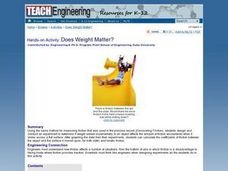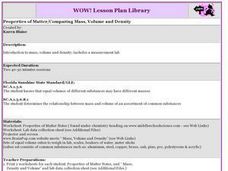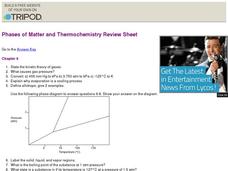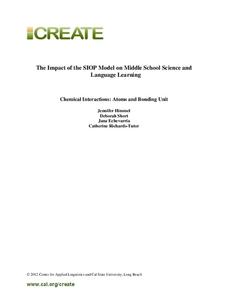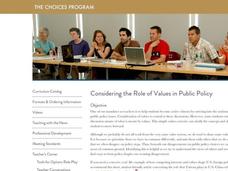Curated OER
How Much Do I Know About Water?
Sixth graders explore how water behaves on a penny. In this states of matter lesson, 6th graders observe water as they add drops to a penny. This lesson helps students apply the adhesive properties of water to the water cycle.
Curated OER
Properties of Matter: "Sink or Swim"
Third graders recognize that different materials have different properties which can be observed such as texture and bouyancy, and compare and contrast, through observation, ability of some objects to float because of action of...
Curated OER
Shape Matters More!
Students investigate shapes as the area changes while the perimeter remains the same. Students demonstrate the shape/perimeter/area relationship using simulations and physical models.
Curated OER
TE Activity: Does Weight Matter?
Students design and conduct experiment to determine if weight added incrementally to an object affects amount of friction encountered when it slides across a flat surface. They graph data from their experiments, and calculate...
Curated OER
Properties of Matter/Comparing Mass, Volume and Density
Young scholars participate in a discussion of volume and density and then engage in a hands on lab. They weigh equal volume cubes at lab stations of an assortment of common substances in a lab setting and record data on their findings on...
Curated OER
Does Size Matter?
Middle schoolers explore chemical solutions. In this chemistry lesson, students investigate the relationship between three related experiments about solutions. Middle schoolers determine variables that affect the chemical concentration...
Curated OER
Catherine Blaine: Seneca Falls and the Women's Rights Movement in the State of Washington
Learners recognize the accomplishments of Catherine Blaine. In this Women's Rights Movement lesson, students research primary and secondary sources about life for American women in the 1800's. Learners trace Blaine's journey from Seneca...
Curated OER
A Matter of Proportion
Students measure the relative heights of the mosaic giraffe and its trainer and compare their proportions to an actual giraffe and zoo trainer.
Curated OER
Earth Matters
Students identify Earth's equator, prime meridian, lines of latitude, lines of longitude, parallels, and meridians.
Curated OER
Money Matters!
Pupils get to build a piggy bank and experiment with coin denominations. Students gather parents and community volunteers to join with them for this class art project. Pupils and volunteers papier-mache an original piggy bank.
Curated OER
Phases of Matter and Thermochemistry
In this theromochemistry worksheet, students review the kinetic theory of gases and the three phases of a substance. Students calculate how much heat is required to raise a certain mass of solution a certain number of degrees. This...
Curated OER
Case Study: Constitutional Law
Posed here is an issue of land ownership and law from the year 1773. Learners can use what they know about the US Constitution, statehood, and Articles I, III, and IV to answer five questions regarding the scenario.
Curated OER
Understanding the Cosmic Microwave Background (CMB)
How did our universe really begin? Explore the Science Big Bang Theory and Cosmic Microwave Background (CMB) with this multiple activity-based lesson that demonstrates that the increase of density due to the decrease of temperatures,...
Cornell University
Polymers: Making Silly Putty
Putty is proof that learning can be fun! Share the wonderful world of polymers with your class through an experiment. Young scientists create their own silly putty, then examine its properties.
Center for Applied Linguistics
Chemical Interactions: Atoms and Bonding
Watch budding chemists interact with the resource on chemical interactions. In the unit, six lessons provide an overview of basic chemistry, from understanding the development of atomic theory to distinguishing between ionic and covalent...
Administrative Office of the US Courts
Snyder v. Phelps
Does the Westboro Baptist Church have the protection of the Constitution when protesting military funerals? High schoolers examine the 2011 Supreme Court case of Snyder v. Phelps before comparing the situation to a fictional...
New York State Education Department
US History and Government Examination: January 2016
Looking for an exam that uses primary sources to test young historians' analytical muscles? Check out a standardized test that asks learners to answer multiple-choice and essay questions to demonstrate their understanding of American...
New York State Education Department
US History and Government Examination: January 2018
It's time to test those skills! Assess pupils' knowledge of US history and government with short answer questions, multiple-choice items, and essays. The resource serves as a standardized test that functions well for a final exam....
Curated OER
"The Missiles of October": The Cuban Missile Crisis, 1962
Young scholars investigate the presence of Soviet missiles in Cuba in 1962 and how that presence triggered an international crisis. The options available to the president as well as the advantages and disadvantages of each are...
Curated OER
Why A Bill of Rights?
Examine conflicting viewpoints in this lesson, in which middle schoolers write their own proposal for including a Bill of Rights in the Constitution. As a class, they discover how the Bill of Rights was not a planned document to be...
Curated OER
Blasphemy! Salman Rushdie and Freedom of Expression
Learners explore the concepts of blasphemy, censorship and freedom of expression through the lens of Salman Rushdie. They also consider how these issues have been reflected in US history.
Curated OER
Flag Day
Students describe the symbolism, tradition, honor and power that flags bear and explore the stories of Civil War battle flags.
Brown University
Considering the Role of Values in Public Policy
Strong opinions come from deeply held values. Young citizens explore the values that are most important to them in a class discussion and activity. As they prioritize a list of values cards that include freedom,...
National Constitution Center
Interactive Constitution
Did you know there are seven Articles and 27 Amendments to the US Constitution? Explore each and every one of them, including the Bill of Rights and other rights around the world, in a super neat US Constitution interactive.
Other popular searches
- Three States of Matter
- Changing States of Matter
- 3 States of Matter
- States of Matter Gases
- Science States of Matter
- Chemistry States of Matter
- States of Matter Lab
- 6 States of Matter
- States of Matter Plasma
- Identifying States of Matter
- Changes in States of Matter
- Matter Changing States



